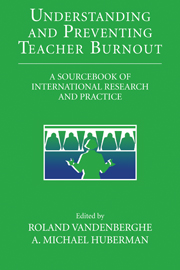Book contents
- Frontmatter
- Contents
- Contributors
- List of Figures
- List of Tables
- Foreword
- Introduction: Burnout and the Teaching Profession
- PART ONE TEACHER BURNOUT: A CRITICAL REVIEW AND SYNTHESIS
- 1 The Nomological Network of Teacher Burnout: A Literature Review and Empirically Validated Model
- 2 Stress and Burnout in the Teaching Profession: European Studies, Issues, and Research Perspectives
- 3 Teacher Stress in a Time of Reform
- 4 Teacher Burnout: A Critical Challenge for Leaders of Restructuring Schools
- 5 Intensification and Stress in Teaching
- 6 Reframing Teacher Burnout in the Context of School Reform and Teacher Development in the United States
- PART TWO TEACHER BURNOUT: PERSPECTIVES AND REMEDIES
- PART THREE TEACHER BURNOUT: A RESEARCH AND INTERVENTION AGENDA
- References
- Index
1 - The Nomological Network of Teacher Burnout: A Literature Review and Empirically Validated Model
Published online by Cambridge University Press: 06 January 2010
- Frontmatter
- Contents
- Contributors
- List of Figures
- List of Tables
- Foreword
- Introduction: Burnout and the Teaching Profession
- PART ONE TEACHER BURNOUT: A CRITICAL REVIEW AND SYNTHESIS
- 1 The Nomological Network of Teacher Burnout: A Literature Review and Empirically Validated Model
- 2 Stress and Burnout in the Teaching Profession: European Studies, Issues, and Research Perspectives
- 3 Teacher Stress in a Time of Reform
- 4 Teacher Burnout: A Critical Challenge for Leaders of Restructuring Schools
- 5 Intensification and Stress in Teaching
- 6 Reframing Teacher Burnout in the Context of School Reform and Teacher Development in the United States
- PART TWO TEACHER BURNOUT: PERSPECTIVES AND REMEDIES
- PART THREE TEACHER BURNOUT: A RESEARCH AND INTERVENTION AGENDA
- References
- Index
Summary
“Burnout”, a term originally coined by Freudenberger (1974) to describe healthcare workers who were physically and psychologically depleted, is now commonly associated with human service professionals such as teachers, nurses, social workers, police officers, physicians, and therapists. (For an historical review of the genesis of the burnout construct, see Maslach, this volume.) In broad terms, the idea represents a response to the chronic emotional strain of dealing extensively with others in need (Maslach, 1982a); to date, however, there is still no universally accepted definition of burnout (Dworkin, 1987; Farber, 1991a; Handy, 1988; Jackson, Schwab, and Schuler, 1986; Shirom, 1989). Even so, most empirical work in the area has embraced the three-component structure proposed by Maslach and Jackson, whose seminal validation research is now widely cited (for reviews, see Maslach and Jackson, 1984, 1986; Farber, 1991a). Based on findings of differential patterns of association between each component and other variables for diverse professional groups, Maslach and Jackson (1984, 1986; Jackson et al., 1986) emphasize that burnout should never be conceptualized as unidimensional; rather, it should be regarded as a multidimensional construct comprising three conceptually distinct yet empirically related facets: emotional exhaustion, depersonalization, and reduced personal accomplishment (see Shirom, 1989, for an alternative perspective).
- Type
- Chapter
- Information
- Understanding and Preventing Teacher BurnoutA Sourcebook of International Research and Practice, pp. 15 - 37Publisher: Cambridge University PressPrint publication year: 1999
- 93
- Cited by

